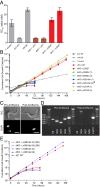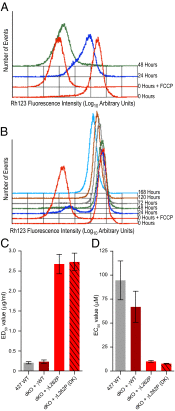Single point mutations in ATP synthase compensate for mitochondrial genome loss in trypanosomes
- PMID: 23959897
- PMCID: PMC3767566
- DOI: 10.1073/pnas.1305404110
Single point mutations in ATP synthase compensate for mitochondrial genome loss in trypanosomes
Abstract
Viability of the tsetse fly-transmitted African trypanosome Trypanosoma brucei depends on maintenance and expression of its kinetoplast (kDNA), the mitochondrial genome of this parasite and a putative target for veterinary and human antitrypanosomatid drugs. However, the closely related animal pathogens T. evansi and T. equiperdum are transmitted independently of tsetse flies and survive without a functional kinetoplast for reasons that have remained unclear. Here, we provide definitive evidence that single amino acid changes in the nuclearly encoded F1FO-ATPase subunit γ can compensate for complete physical loss of kDNA in these parasites. Our results provide insight into the molecular mechanism of compensation for kDNA loss by showing FO-independent generation of the mitochondrial membrane potential with increased dependence on the ADP/ATP carrier. Our findings also suggest that, in the pathogenic bloodstream stage of T. brucei, the huge and energetically demanding apparatus required for kDNA maintenance and expression serves the production of a single F1FO-ATPase subunit. These results have important implications for drug discovery and our understanding of the evolution of these parasites.
Keywords: RNA editing; dourine; dyskinetoplastic; mitochondrial DNA; surra.
Conflict of interest statement
The authors declare no conflict of interest.
Figures




Similar articles
-
Oxidative Phosphorylation Is Required for Powering Motility and Development of the Sleeping Sickness Parasite Trypanosoma brucei in the Tsetse Fly Vector.mBio. 2022 Feb 22;13(1):e0235721. doi: 10.1128/mbio.02357-21. Epub 2022 Jan 11. mBio. 2022. PMID: 35012336 Free PMC article.
-
Adaptations of Trypanosoma brucei to gradual loss of kinetoplast DNA: Trypanosoma equiperdum and Trypanosoma evansi are petite mutants of T. brucei.Proc Natl Acad Sci U S A. 2008 Feb 12;105(6):1999-2004. doi: 10.1073/pnas.0711799105. Epub 2008 Feb 1. Proc Natl Acad Sci U S A. 2008. PMID: 18245376 Free PMC article.
-
Reduced Mitochondrial Membrane Potential Is a Late Adaptation of Trypanosoma brucei brucei to Isometamidium Preceded by Mutations in the γ Subunit of the F1Fo-ATPase.PLoS Negl Trop Dis. 2016 Aug 12;10(8):e0004791. doi: 10.1371/journal.pntd.0004791. eCollection 2016 Aug. PLoS Negl Trop Dis. 2016. PMID: 27518185 Free PMC article.
-
Natural and induced dyskinetoplastic trypanosomatids: how to live without mitochondrial DNA.Int J Parasitol. 2002 Aug;32(9):1071-84. doi: 10.1016/s0020-7519(02)00020-6. Int J Parasitol. 2002. PMID: 12117490 Review.
-
Mitochondrial genome maintenance-the kinetoplast story.FEMS Microbiol Rev. 2023 Nov 1;47(6):fuac047. doi: 10.1093/femsre/fuac047. FEMS Microbiol Rev. 2023. PMID: 36449697 Free PMC article. Review.
Cited by
-
ATPaseTb2, a unique membrane-bound FoF1-ATPase component, is essential in bloodstream and dyskinetoplastic trypanosomes.PLoS Pathog. 2015 Feb 25;11(2):e1004660. doi: 10.1371/journal.ppat.1004660. eCollection 2015 Feb. PLoS Pathog. 2015. PMID: 25714685 Free PMC article.
-
African animal trypanocide resistance: A systematic review and meta-analysis.Front Vet Sci. 2023 Jan 4;9:950248. doi: 10.3389/fvets.2022.950248. eCollection 2022. Front Vet Sci. 2023. PMID: 36686196 Free PMC article.
-
Homologue replacement in the import motor of the mitochondrial inner membrane of trypanosomes.Elife. 2020 Feb 27;9:e52560. doi: 10.7554/eLife.52560. Elife. 2020. PMID: 32105215 Free PMC article.
-
Elucidating the possible mechanism of action of some pathogen box compounds against Leishmania donovani.PLoS Negl Trop Dis. 2020 Apr 10;14(4):e0008188. doi: 10.1371/journal.pntd.0008188. eCollection 2020 Apr. PLoS Negl Trop Dis. 2020. PMID: 32275665 Free PMC article.
-
The non-canonical mitochondrial inner membrane presequence translocase of trypanosomatids contains two essential rhomboid-like proteins.Nat Commun. 2016 Dec 19;7:13707. doi: 10.1038/ncomms13707. Nat Commun. 2016. PMID: 27991487 Free PMC article.
References
-
- Hoare CA. The Trypanosomes of Mammals. A Zoological Monograph. Oxford: Blackwell; 1972.
-
- Claes F, Büscher P, Touratier L, Goddeeris BM. Trypanosoma equiperdum: Master of disguise or historical mistake? Trends Parasitol. 2005;21(7):316–321. - PubMed
-
- Jensen RE, Englund PT. Network news: The replication of kinetoplast DNA. Annu Rev Microbiol. 2012;66:473–491. - PubMed
Publication types
MeSH terms
Substances
Associated data
- Actions
Grants and funding
LinkOut - more resources
Full Text Sources
Other Literature Sources

